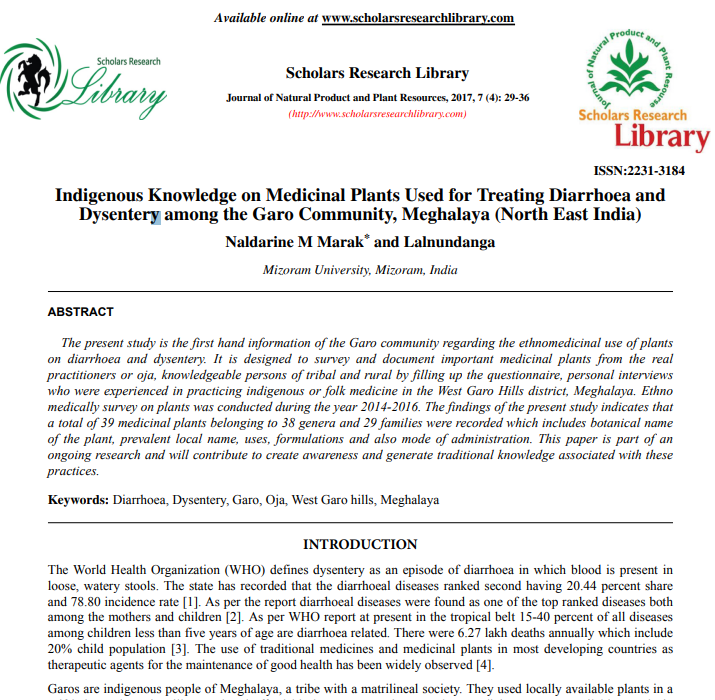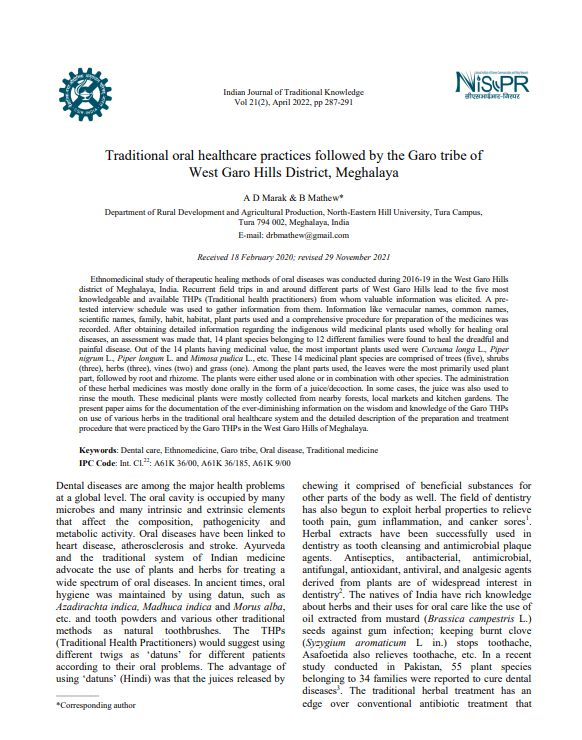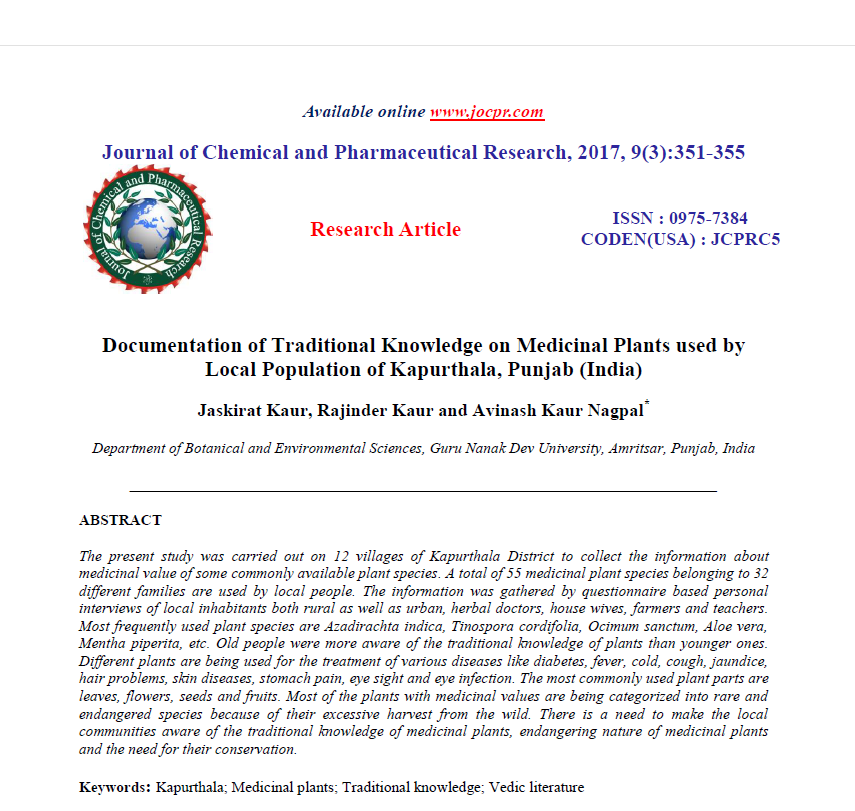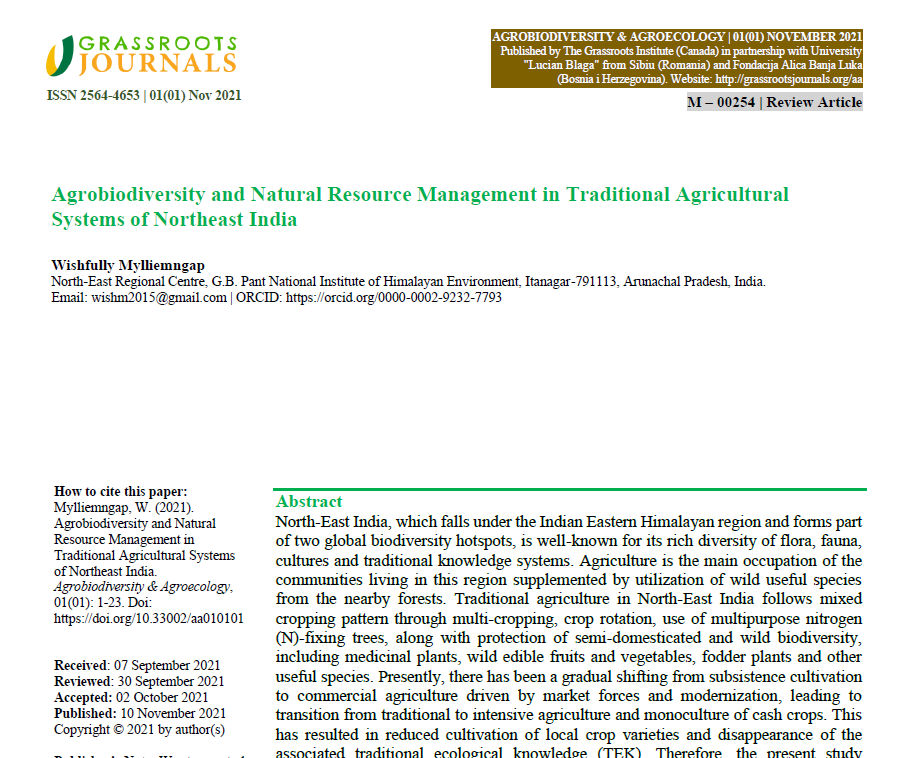Research Papers/Articles
Indigenous Technical Knowledge (ITK) Practiced by Dairy and Piggery Farmers in Meghalaya
2019
Author(s): Shadap DM, Dkhar SE
The study was conducted in two districts viz. East Khasi Hills and Ri-Bhoi districts taking two villages from each district on Indigenous Technical Knowledge (ITK) in the field of animal husbandry and veterinary.
Sacred Groves of Meghalaya: A Review
2015
Author(s): Kharkongor BM, Tiwari BK
This review paper highlights some of the works done on sacred groves with special emphasis on the sacred groves of Meghalaya in North-east India

Indigenous Knowledge on Medicinal Plants Used for Treating Diarrhoea and Dysentery among the Garo Community, Meghalaya (North East India)
2017
Author(s): Marak NM, Lalnundanga
Ethnomedically survey on plants was conducted during the year 2014-2016. The findings of the present study indicates that a total of 39 medicinal plants belonging to 38 genera and 29 families were recorded which includes botanical name of the plant, prevalent local name, uses, formulations and also mode of administration.

Traditional Oral Healthcare Practices Followed by the Garo Tribe of West Garo Hills District, Meghalaya
2022
Author(s): Marak AD, Mathew B
This paper revealed the ethnomedicinal study conducted in Meghalaya's West Garo Hills district between 2016 and 2019 uncovered 14 indigenous plant species, including Curcuma longa and Mimosa pudica, employed by Traditional Health Practitioners to heal oral diseases.
Ethnic Preparation of Chubitchi, an Alcoholic Beverage of the Garo Tribe of Meghalaya: A Sociocultural Analysis
2021
Author(s): Marak S R , Sharma D , Sarma H
This paper deals with the traditional preparation of Chubitchi by the Garo tribe, which is a vital part of their culture, and also examines the sociocultural significance of the beverage.
Traditional Knowledge and Biodiversity Conservation in the Sacred Groves of Meghalaya
2006
Author(s): Jeeva S , Mishra BP , Venugopal N ,Kharlukhi L, Laloo RC
This study shows how the Meghalaya Sacred Groves are considered to be the most species-rich areas for plants, birds and mammals. The mythological stories and indigenous knowledge associated with the groves have been the principal factor in preserving the sacred groves in the immaculate condition.
Plant Indicators for Agricultural Seasons Amongst Pnar Tribe of Meghalaya
2006
Author(s): Samati H, Begum SS
The work relates to Pnar tribe of Jaintia Hills district, Meghalaya, whose main occupation is agriculture. Even today they depend on plant species as indicators, such as Butea buteiformis (Voigt) Grier. & Long, Castanopsis indica A. DC., Castanopsis tribuloides (Sm.) DC., Phoenix humilis Royle ex Becc. & Hook. f., Pinus kesiya Royle ex Gord., Quercus serrata Thunb., Schima wallichii (DC.) Korth. for systematizing steps they followed season wise for achieving the best productivity of rice and other agricultural crops.

Documentation of Traditional Knowledge on Medicinal Plants used by Local Population of Kapurthala, Punjab (India)
2017
Author(s): Kaur J, Kaur R and Nagpal AK
A total of 55 medicinal plant species belonging to 32 different families are used by local people. The information was gathered by questionnaire based personal interviews of local inhabitants both rural as well as urban, herbal doctors, house wives, farmers and teachers. Most frequently used plant species are Azadirachta indica, Tinospora cordifolia, Ocimum sanctum, Aloe vera, Mentha piperita, etc.
Traditional Knowledge Associated with Fish Harvesting Practices of War Khasi Community of Meghalaya
2008
Author(s): Tynsong H , Tiwari BK
The paper reports and analyses the findings of Traditional Ecological Knowledge associated with fish harvesting practices of War Khasi community, a sub tribe of Khasi, inhabiting southern slopes of Meghalaya.

Agrobiodiversity and Natural Resource Management in Traditional Agricultural Systems of Northeast India
2021
Author(s): Mylliemngap W
This paper highlights there has been a gradual shifting from subsistence cultivation to commercial agriculture driven by market forces and modernization, leading to transition from traditional to intensive agriculture and monoculture of cash crops.



